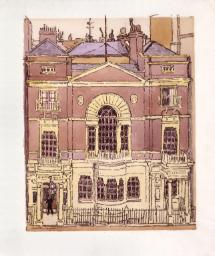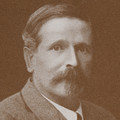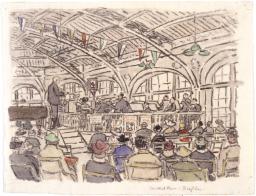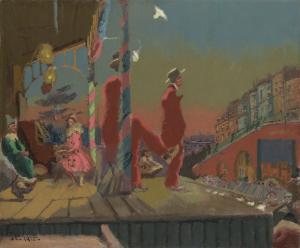Walter Taylor 1860–1943
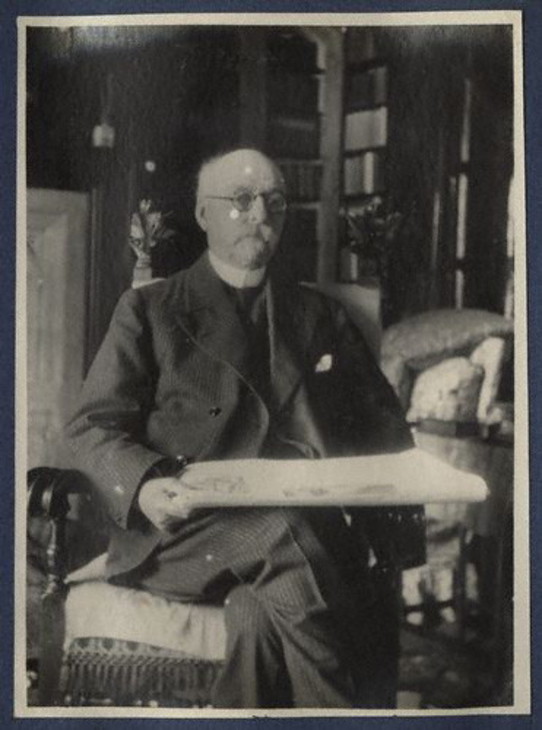
Lady Ottoline Morrell 1873–1938
Walter Taylor 1923–4
Vintage snapshot print
153 x 108 mm
National Portrait Gallery, London
Photo © National Portrait Gallery, London
Fig.1
Lady Ottoline Morrell
Walter Taylor 1923–4
National Portrait Gallery, London
Photo © National Portrait Gallery, London
To his contemporaries Taylor always seemed old. The writer Osbert Sitwell (1892–1969) said that with his ‘red face and white imperial, his prominent nose, slow movements, leisurely gait, and with a little the air of a seaside dandy, [Taylor] appeared always to be elderly. Everything about him seemed to be leisurely, not least so his voice, with something of an inescapable boredom in its slow, single-toned unemphatic flow.’3 Yet his old-fashioned nature and premature seniority were tempered by a love of the modern in art and literature. A friend Marjorie Lilly described him as ‘prey to the rage for the day after tomorrow’.4 The critic W.J. Turner recalled that he was a ‘reserved and taciturn man but though silent he was genial, and an ideal host who stimulated conversation as he much appreciated wit and was thoroughly well-read’.5 Apparently Taylor only had one eye, although this does not seem to have affected his enthusiasm for painting.6 Spencer Gore’s son Frederick recollected that, following an amusing incident arising from Taylor’s affection for ‘a famous lady who ran an uproarious hotel in Duke Street (caricatured by Evelyn Waugh as Lottie Crump in Vile Bodies)’, he was dubbed ‘Can eye Taylor’. The artist Fred Mayor (1865–1916) and the writer Arnold Bennett (1867–1931) apparently listened at a locked door while Taylor wooed the object of his affection, imploring her, ‘Can I, can I ...?’7 The Chilean artist Alvaro Guevara (1894–1951) painted a portrait of Taylor in 1918. It was hailed as one of Guevara’s most successful works and was sold to the Contemporary Art Society in 1936, but its whereabouts are now unknown.8
Taylor was never an official member of the Camden Town Group but he operated in a modest way on the periphery of Sickert’s circle. In October 1911 he shared an exhibition at the Carfax Gallery with a fellow watercolourist, Douglas Fox Pitt (1864–1922). His work was also included in the Exhibition of the Work of English Post-Impressionists, Cubists and Others at the Public Art Galleries, Brighton, December 1913–January 1914. This exhibition, organised by Spencer Gore, marked a transitional stage between the Camden Town Group and the London Group. Gore’s son Frederick recalled that his father stayed with Taylor in Brighton during 1913 and that Taylor was on friendly terms with a member of Brighton Town Council. This possibly explains why the exhibition was held in Brighton rather than London.
In 1914 Taylor’s connections with London’s avant-garde were more formally recognised when he was elected to the newly formed London Group. He remained an active participant until 1934 and served as Treasurer during 1916–18. He also exhibited with Lucien Pissarro and James Bolivar Manson’s Monarro Group during the 1920s. Taylor most often painted landscapes or architectural subjects and his post-war watercolours look very like those of his close friend and colleague, Fox Pitt; both men painted with flat blocks of colour applied within a bold charcoal outline. In reaction to the modern European paintings which he loved to collect, Taylor’s style later became freer with brighter, rich colours. His work never attracted much attention, but he continued to paint and occasionally exhibit until the 1930s. Sickert wrote the preface to an exhibition of Taylor’s watercolours at R.E.A. Wilson Gallery, London, in November 1932 in which he praised the artist’s ability to ‘pick off the quintessence of a scene’ as ‘a rare and precious achievement’.9
Taylor’s real importance to the history of the Camden Town Group lies in his role as a patron. Having been introduced by Sickert to the Fitzroy Street Group he was a frequent customer at their Saturday afternoon ‘At Home’ sales. Jan Gordon, critic for the Observer, recalled in 1936 how the rumour that Taylor might attend ‘would make the hearts of the younger progressives living about Fitzroy-square or Charlotte street beat a little faster ... To be bought by Mr. Taylor was almost equivalent to receiving a mention in the despatches of contemporary painting.’10 Taylor’s purchases were sometimes intended as much as a support for the artist as for his own benefit. Most of the artists who showed their work at Fitzroy Street, including Sickert, were frequently in severe financial straits and Taylor’s generous patronage was a vital source of income. Taylor gradually amassed a large collection of work by Sickert and his contemporaries including Harold Gilman’s Leeds Market (Tate N03684) and Canal Bridge, Flekkefjord (Tate N04273), now both in Tate’s collection. He also owned Sickert’s Noctes Ambrosianae 1906 (Nottingham Castle Museum and Art Gallery),11 described by the artist as a ‘picture of boys in the gallery at the Middlesex ... one of, perhaps, not more than a dozen museum pieces I have done in twenty-seven years!’12 W.J. Turner noted that Taylor’s collection included works by Matthew Smith, Stanley and Gilbert Spencer and Mark Gertler whom Taylor supported until Gertler’s death in 1939. He was also one of the first British collectors of French modernist painters such as Henri Matisse, Pierre Bonnard, Edouard Vuillard and Raoul Dufy.13 Works by these latter artists were sometimes bought at the expense of others in his collection and the critic Frank Rutter recorded that Taylor sold notable British paintings by Gilman, Gore and Robert Bevan in order to buy French works.14
Taylor’s support of the Camden Town Group extended beyond the purchase of their works. His hospitality towards his friends was generous and he frequently entertained Sickert, Gore, Bevan and others at his homes in London and Brighton. He was godfather to Spencer Gore’s son, Frederick, who was taken by his mother to lunch with him once a year.15 Taylor continued to send Gore’s widow £100 a year until Frederick reached the age of twenty-one in 1944; he also left his godson £100 in his will.
Taylor died on 15 June 1943 aged eighty-three. The Leicester Galleries staged a memorial exhibition of his work in April 1944. Many of his watercolours are still in private hands but examples of his painting can be seen in the collection of Brighton and Hove Museums. In addition, many works from his collection by Camden Town Group and other modern British artists have since found their way into public collections.
Notes
Osbert Sitwell (ed.), A Free House! Or the Artist as Craftsman: Being the Writings of Walter Sickert, London 1947, pp.xxxv–xxxvi.
W.J. Turner, ‘Walter Taylor’, in Water-colours by the Late Walter Taylor, exhibition catalogue, Leicester Galleries, London 1944, p.3.
Walter Richard Sickert, ‘Walter Taylor’, in Exhibition of Water Colour Drawings by Walter Taylor, R.E.A. Wilson, London 1932, in Anna Gruetzner Robins (ed.), Walter Sickert: The Complete Writings on Art, Oxford 2000, p.623.
Quoted in David Buckman, Brighton Yesterdays: Douglas Fox Pitt, 1864–1922, and Walter Taylor, 1860–1943, exhibition catalogue, Maltzahn Gallery, London 1973, [p.1].
Catalogue entries
How to cite
Nicola Moorby, ‘Walter Taylor 1860–1943’, artist biography, February 2004, in Helena Bonett, Ysanne Holt, Jennifer Mundy (eds.), The Camden Town Group in Context, Tate Research Publication, May 2012, https://www

